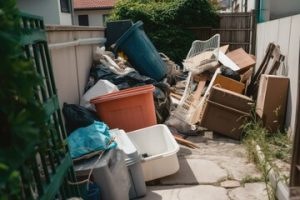The process of clearing space has evolved beyond basic tearing down and hauling away. Modern rubbish removal and demolition are now deeply connected to safety, sustainability, and efficiency. They no longer exist as separate steps but as an integrated system designed to prepare environments for new beginnings. This shift has created innovative practices that are reshaping how we approach destruction and disposal.

At its core, demolition today is no longer about brute force but about controlled deconstruction. Teams use precision methods to dismantle structures in a way that minimizes dust, vibration, and disruption. Every piece removed is examined for potential reuse or recycling before disposal. This careful breakdown reduces environmental impact while improving safety for workers and communities.
Rubbish removal, once considered an afterthought, has become a crucial stage of any demolition project. The waste generated from tearing down walls, floors, and entire buildings is carefully sorted into categories. Metals, wood, concrete, and glass are all separated to maximize recycling opportunities. What remains is handled with strict disposal protocols to ensure compliance with environmental standards.
One of the biggest advancements in this field is the use of smart machinery. Remote-controlled demolition robots now allow workers to stay out of hazardous zones. These machines can dismantle concrete and steel with precision while producing less noise and dust. Similarly, advanced collection vehicles use compacting technology to transport more waste in fewer trips.
Safety protocols have also transformed how demolition is executed. Before any physical work begins, extensive site assessments are carried out to identify structural weaknesses and hazardous materials. This ensures that no surprises occur once walls start coming down. Specialized teams are also trained to deal with harmful substances like asbestos or lead during rubbish removal.
Urban environments present unique challenges that require even more refined approaches. Limited space, nearby infrastructure, and heavy pedestrian traffic demand controlled demolition techniques. Rather than explosive takedowns, methods like high-reach excavators or interior strip-outs are preferred. Rubbish removal teams coordinate closely with demolition crews to ensure debris is cleared as sections are dismantled.
Sustainability has become a major driver behind new demolition and waste strategies. Companies are under increasing pressure to reduce landfill contributions and carbon emissions. One solution has been the rise of circular demolition, where materials are not just recycled but repurposed for new construction projects. This creates a closed-loop system that benefits both the environment and the economy.
Another innovative trend is selective demolition, often called “soft stripping.” Instead of demolishing an entire building, only specific components are removed. Fixtures, windows, flooring, and structural elements are carefully extracted and reused elsewhere. This minimizes waste and preserves valuable materials that would otherwise be discarded.
Digital technology now plays a significant role in planning and execution. Advanced scanning tools map the internal structure of a building before demolition begins. This data helps teams decide which parts can be salvaged and how to dismantle them most effectively. It also improves coordination between demolition crews and rubbish removal units, ensuring a seamless workflow.
Public health and community impact are also central concerns in modern projects. Dust suppression systems, noise barriers, and controlled transport routes are implemented to reduce disruption. Debris is often moved during off-peak hours to limit traffic congestion. Every step of the process is designed to protect not just the environment but also the people who live and work nearby.
Rubbish removal has also expanded to include more specialized services beyond construction waste. Hazardous material disposal, electronic waste handling, and organic debris management are now part of the industry. This diversification ensures that every type of waste generated during demolition is dealt with appropriately. It reflects a growing awareness of how different materials affect ecosystems and human health.
The economic implications of these advancements are significant. Efficient demolition and waste management can greatly reduce project costs and timelines. Recycled materials can offset expenses and even generate revenue. Moreover, compliance with environmental regulations helps avoid costly penalties and improves public trust.
In residential settings, the same principles are applied on a smaller scale. Home demolitions and renovations now incorporate recycling and selective removal techniques. Homeowners are increasingly aware of their environmental footprint and choose companies that prioritize sustainable practices. Even garden sheds and driveways are being removed with an eye toward reuse and minimal waste.
One often-overlooked aspect of modern rubbish removal is data tracking. Detailed logs are maintained for every piece of material removed from a site. This documentation not only ensures legal compliance but also provides valuable insight for future projects. Patterns in material recovery rates, disposal costs, and recycling potential can inform better planning and decision-making.
The cultural shift toward environmental responsibility has made clients more discerning. Many now demand sustainability reports as part of demolition contracts. Transparency about where waste goes and how it is processed has become a competitive advantage. This demand pushes the industry to innovate continuously and adopt greener solutions.
Another rising concept is deconstruction for reuse rather than demolition for disposal. In this approach, entire structures are carefully dismantled piece by piece. Components like bricks, beams, and doors are preserved for new builds. This method takes more time but significantly reduces waste and creates a supply of valuable reclaimed materials.
Training and workforce development have also evolved alongside technology. Workers now need skills in material identification, digital scanning, and environmental compliance. Certification programs ensure they can operate new machinery safely and sustainably. These skilled professionals form the backbone of the modern rubbish removal and demolition industry.
The future of this field points toward even more integration of technology and sustainability. Artificial intelligence could soon analyze building compositions to optimize demolition strategies. Drones might monitor debris removal in real time, providing data for more efficient logistics. These advancements will continue to make demolition safer, faster, and more environmentally responsible.
However, challenges remain despite these innovations. Illegal dumping, insufficient recycling infrastructure, and varying regulatory standards can slow progress. Collaboration between governments, private companies, and communities is essential to overcome these barriers. Only through collective effort can the industry achieve its full potential.
The intersection of demolition and rubbish removal is no longer just about clearing space. It has become a sophisticated field focused on resource management, environmental stewardship, and technological innovation. As cities grow and old structures make way for new ones, this industry will continue to shape the landscape of progress.
Every building that falls now carries the promise of a smarter, cleaner, and more sustainable future. The debris left behind is no longer just waste but an opportunity to rebuild responsibly. With each demolition project, we learn new ways to balance development with preservation. And in that balance, the future of rubbish removal and demolition is being rewritten.
